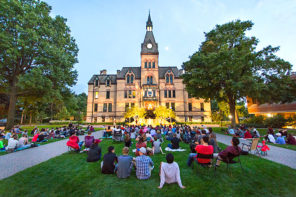Yogyakarta, Indonesia.
Four years ago on the day after Christmas, a killer tsunami struck the province of Aceh in North Sumatra. Hundreds of thousands died, many more were left homeless and destitute. Entire villages, towns, and cities were destroyed. I know several survivors who lost all of their relatives—husbands, wives, children, parents, and others—all of them gone, most with out a trace or even bodies to bury and mourn. Many were left with literally only the clothes on their backs, and some did not have even that.
Hundreds of thousands, perhaps millions, suffer from disaster-induced psychological trauma. Nothing can replace family members and friends whose lives were swept away. In days and weeks following a calamity, the world focuses more on the material need of victims than it does on their psychological and religious needs. At such times, lives hang in the balance. For many, survival depends on the speed with which clean water, food, shelter, and emergency medical care are delivered. At such moments, emotional and religious needs seem less pressing.
This year on the fourth anniversary of the tragedy, I participated in an evening of prayer and remembrance celebrating the lives, faith, and culture of those who perished in Aceh. It was in sponsored by a collation of Acehenese Indonesian and Yogyakarta governmental and civil society and student organizations described as “Peace Expo—Peace for Our Country and Enduring Brotherhood.”
While the physical and psychiatric symptoms of disaster-induced trauma are universal, they manifest differently according to social, cultural, and religious contexts—and require different healing strategies. This event was one small element of a larger process through which Islam and its culture are being used to bring healing to people in and from Aceh.
Background
The horror and trauma of the Tsunami was something new for the people of Aceh, but the devastation of human-made disaster is something that they have experienced for many generations, almost without respite. The region has suffered from more than a century of armed conflict, ranging from large-scale, very nearly genocidal military campaigns conducted by Dutch forces, to more recent low-level insurgency and counter-insurgency warfare.
The Acehenese have long resisted foreign domination. They are deeply religious Muslims and describe their homeland as the “Veranda of Mecca” because of its location at the northwestern border of the Malay Archipelago and proximity to the Holy Lands of Islam. For centuries Aceh was also among the most important centers of the spice trade, a market that was nearly as important in the global economy as the oil trade is today. For more than four hundred years, conflict in Aceh centered on control of this trade. It pitted the Acehenese against the Portuguese and later against the Dutch and British, and earned them a well-deserved reputation for tenacious defense of their homeland and commercial interests—and an undeserved reputation as religious fanatics.
Acehenese resistance has always been as much nationalist as Islamic. Members of the the Gerkan Aceh Merdeka (GAM, or Aceh Independence Movement) I interviewed several years before the tsunami claimed that Aceh had never accepted Dutch or Indonesian rule, and that they were engaged in a struggle for national independence—not unlike that of the United States in the eighteenth century. They often described the Indonesian government as “colonialist” and mentioned a 17th-century treaty between one of the Sultans of Aceh and the British East India Company that guaranteed their independence as “proof” they were not part of the former Netherlands Indies or modern Indonesia.
For more than a century, Dutch Christian colonials and Indonesian secular nationalists found it convenient to label the Acehenese as Islamic fanatics, extremists, terrorists—or by whatever term currently in vogue for demonizing Muslim resistance to foreign aggression and domination. But Acehenese Islam has little in common with the Islamist theologies prevalent among violence-prone groups in Indonesia and elsewhere.
Like other local Islams in Southeast Asia, Islam in Aceh has been shaped by local culture and by Sufi mystical traditions. Sufism and other mysticisms are not inherently peaceful: They can be as violent as any other form of religion. But it does clearly distinguish Acehenese Islam from the austere Puritanism of contemporary Wahhabi-influenced militants who seek, more than anything else, to impose their religious views on others.
Among the aspects of Islam that are most important for understanding Acehenese responses to trauma are the emphasis it places on hospitality (zikhr), or the ritualized remembrance of God (ziyarah), or visiting graves, and theology of divine determinism (takdir), according to which God actively intervenes in human affairs. There is also an Acehenese proverb drawn from the Qur’an that states that in the face of adversity people should “hold fast to the rope of God.”
They have always identified resistance with jihad or “Struggle in the Path of God,” which, given their history, religion, and culture, should not be difficult to understand. In the face of suffering many have found solace in the traditional Muslim theodicy that the world as it exists today is the most perfect and beautiful of all possible worlds, because it is the world that God has chosen to create at this time—but that this does not preclude the possibility that in response to the actions and prayers of humans, God may choose to create a world which is even more beautiful and perfect.
For many Acehenese, this possibility is what healing the wounds of war and natural disaster is about. For too many, there are no graves to visit. Some Acehenese spend evenings sitting on the beach when they would normally be visiting the tombs of relatives. Others search in vain for the graves of loved ones lost in the conflict or hope in vain that those who simply disappeared will return. The “Rope of God” and hope for a more perfect world are all that they have.
While the tsunami brought unprecedented destruction, it seems to have contributed to a peace process that began with the fall of the authoritarian military regime governing Indonesia and terrorizing Aceh a decade ago. Some well-meaning but naïve American Christians I have met here in Indonesia have attributed this development to their own humanitarian gestures which, they believe, have shown the Acehenese that outsiders and especially Christians are “not all bad.” No evidence other than wishful thinking supports this view. It is more reasonable to suggest that a combination of new Indonesian policies emphasizing decentralization and Acehenese Islamic theodicy are responsible.
Garden of Culture
The Peace Expo was held in Yogyakarta’s “Garden of Culture,” a colonial-era complex that is now Indonesian cultural space and was, for one evening, Acehenese religious and cultural space. This irony was not lost on the Acehenese who organized the program. The evening began with a slideshow of the devastation wrought by the tsunami: villages and towns without a single building standing; overturned cars, trucks, and buses; bloated corpses. It was very graphic and deeply disturbing.
This was followed by the gracious traditional dance used by Acehenese to welcome guests, especially those coming from abroad. Its origins can be traced to performances used by the Sultans of Aceh to greet foreign dignitaries. It is perfumed by young women who offer guests gifts of sihir (a mild stimulant common in South and Southeast Asia, also known as betel or pan; it is a nut wrapped in leaves and chewed, but not swallowed, and it stains the teeth bright red.) Sirih is an acquired taste and a gift that can not be refused. Accepting it is a gesture of peace and a sign of respect. It was not refused by any of the 300 in attendance.
Most of the evening was devoted to prayer and ritual. The first was Qur’an recitation, which repeats what Muslims believe to be literally the “Speech of God” as revealed to the Prophet Muhammad. It is a blessing for those who perform it and those who hear it. The second were zikhr and shawalat (remembrance of the Prophet Muhammad) performed by groups of young men and women. These are sometimes called “dance” but that entirely misses the point. They are local variants of Sufi devotional practices common throughout the Muslim world. They are intricate, stunningly beautiful rhythmic devotions, performed in a uniquely Acehenese style that includes hand clapping, finger snapping, and chest tapping. The movements are progressively faster, in time with chanted prayers calling on God and in remembrance of the Prophet.
Prayer for Peace and Reconstruction
The program of ritualized remembrance was followed by a long and heartfelt prayer by an Acehenese Muslim scholar. His theme was that “tonight we can feel the breeze of peace blowing through Aceh, Indonesia and the world.” He explained that God had sent destruction to Aceh because people had forgotten Him and fallen away from Islam. He asked for forgiveness for himself, Aceh, and humanity. He asked God for blessing and mercy, and also called on Acehenese, and especially on Acehenese students, to study diligently and return home to help in the rebuilding process.
These were moving and powerful words with a message not just for Acehenese Muslims, but for humanity as a whole. The evening ended with a reminder that the tsunami of 2004 was a tragedy, not just for Aceh and Indonesia but for the world. A series of amateur videos by Western tourists in Malaysia and Thailand showed the tsunami striking beach resorts in all of its force. It did not distinguish between Asians and Westerners, or between Muslims and non-Muslims. It was an equal-opportunity killer. This evening was not just for Acehenese Muslims, but for people of all faiths and ethnicities.
Theodicy seeks to explain why it is that a benevolent divinity would allow tragedy to overtake humanity. At its best, theodicy offers hope not just for rebuilding what was, but hope for a genuinely more perfect and beautiful world. This one evening in Yogyakarta offered this hope and the “Rope of God” to the world. Indonesians generally applaud at the conclusion of cultural performance—this evening everyone left in what can only be called contemplative silence.




